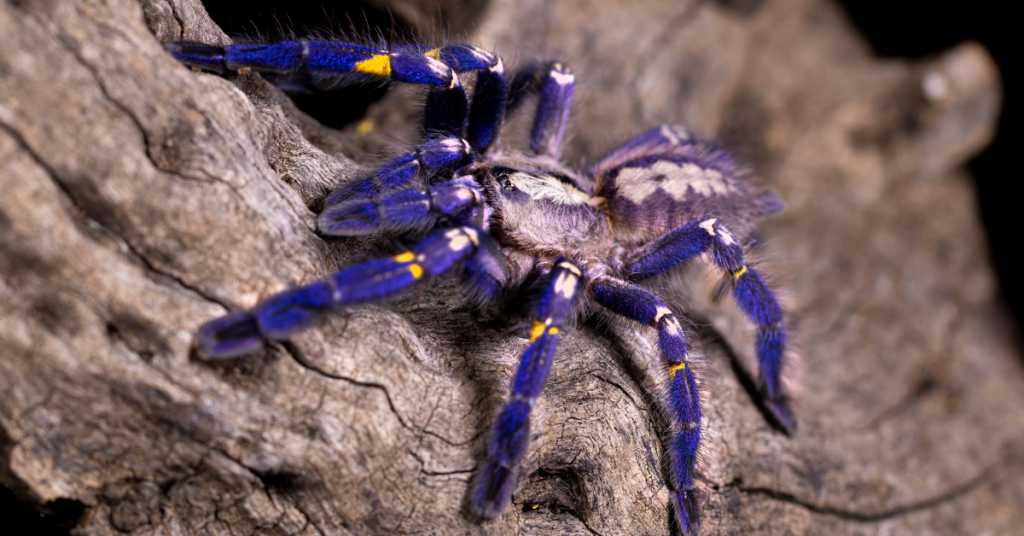
The Peacock tarantula (Poecilotheria metallica) is an Old World species of tarantula. It is the only blue species of the genus Poecilotheria.
Like others in its genus it exhibits an intricate fractal-like pattern on the abdomen. The species’ natural habitat is deciduous forest in Andhra Pradesh, in central southern India.
It has been classified as critically endangered by the IUCN.
Colouration
Poecilotheria metallica has similar intricate geometric body coloration as other Poecilotheria species, but it is the only species in the genus to be covered in blue hair.
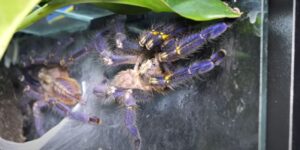
While it is young, P. metallica is less chromatic, the colouring turns to blue as it matures.
Males also have more slender bodies, with longer legs. The definitive trait of a mature male is the revelation of emboli at the end of their pedipalps following their “mature molt.”
Females tend to lose their blue colouration and develop a darker black colouring.
When full size, the leg span of P. metallica is 15–20 cm (6–8 in).
Habitat
Poecilotheria metallica’s behaviour parallels that of many arboreal spiders. In the wild, P. metallica lives in holes of tall trees where it makes asymmetric funnel webs.
The primary prey consists of various flying insects.
Spiders of this genus may live communally when territory, i.e. the number of holes per tree, is limited.
The species is skittish and will try to flee first, and will also flee when light shines upon it, as it is a photosensitive species.
Are Peacock Tarantulas Venomous?
There has never been a recorded human death from its bite. However, it is considered medically significant, with venom that may cause intense pain.
The vast majority are “dry bites,” where no venom is injected into the handler.
The mechanical effects of the bite can still be worrisome, as an adult’s fangs can reach nearly 3/4 of an inch in length.
P. metallica can move rapidly and may defend itself when cornered. Venom may produce a heart-rate increase followed by sweating, headache, stinging, cramping, or swelling.
Effects can last for up to a week.
However, in extreme bites, effects may still be felt months later.
Feeding
Though Poecilotheria species seem to prefer flying insects such as moths, they will feed eagerly on crickets, grasshoppers, and large specimens will even feed on an occasional small mouse.
Keeping in Captivity
Housing
The Peacock tarantula is an arboreal species. It should therefore be kept in a large, vertically oriented enclosure. They need a well-ventilated enclosure with relatively high humidity.
If the enclosure becomes too dry, the spiders will not do well.
One way to overcome the dilemma of high humidity and high ventilation is to use a deep (4 to 5″) substrate of damp sand and peat moss and to provide several live plants within the enclosure.
These plants can be placed within the enclosure still in their pots or can be planted in the deep substrate.
Live plants will not only provide excellent places for the spiders to establish homes, but they will also provide excellent areas for breeding and egg-laying.
Add one or two shallow water dishes and mist the entire enclosure once a day to every other day, depending on the conditions of the room in which the enclosure is located.
The cage should be allowed to dry out in between misting.
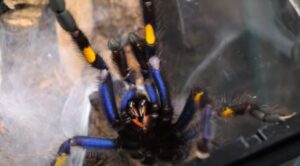
Cage Care
It is a very good idea to clear up any uneaten prey items the day after feeding your P. metallica as decaying organic matter commonly attracts mites, fungus, mold and other potentially harmful organisms into the enclosure.
As with all tarantulas, if your pet has recently molted, remove uneaten prey items immediately.
Breeding
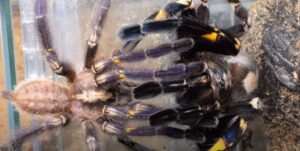
Mature male peacock tarantulas are slender and long-legged compared to females and they have no tibial hooks for mating.
They are also beautifully covered in more intense metallic blue coloration.
An adult male should be carefully introduced into the female’s enclosure after he has produced a sperm web. It is imperative that the female is very well-fed before any introductions as Poecilotheria females are notorious for attacking and eating males before any mating can occur.
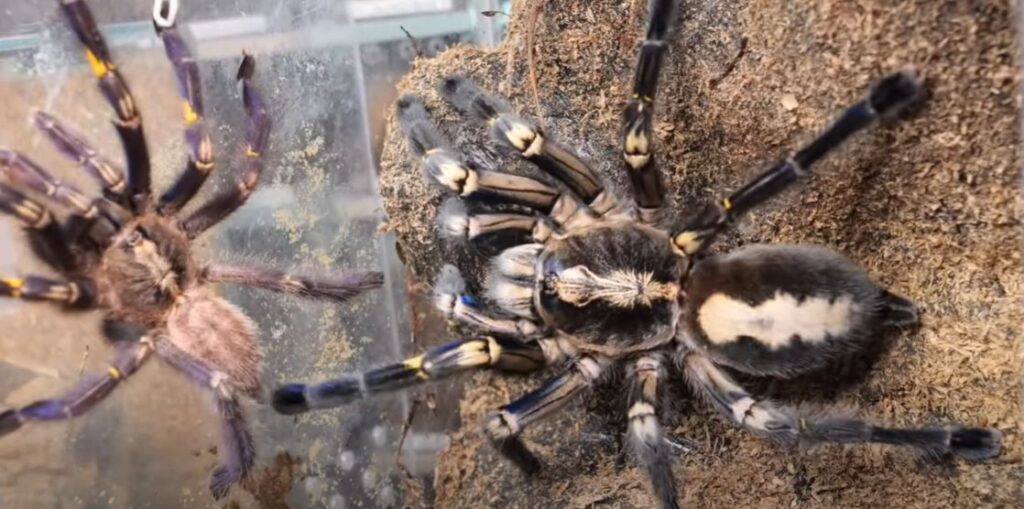
As you can see from the above image, females are much larger than males.
Once mating occurs, the female should be fed in anticipation of an egg sac.
The poecilotheria metallica is, in our view, the most stunning tarantula in the whole of the tarantula kingdom.
We have put together the above basic article on these creatures, more so because we love them so much rather than anything else! Shhhh!
